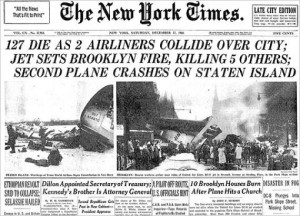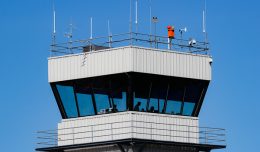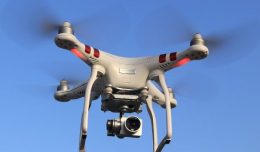(Note: Crew fatigue and crew rest have been a hot topic in the airline industry for the past several years, this year especially with the emergence of Federal Aviation Regulation (FAR) 117. In a 3-part series this week, NYCAviation will explore the issue, its history, pilot experiences, and its solutions, all from the perspective of three different pilots whose duty it is to keep you safe. In Part One, former pilot John Steffen introduces the topic by sharing the history of crew fatigue and the ghosts of regulations past. We hope you walk away with a strong understanding of the importance of this subject, as safety is something we all have a say in. – Phil Derner, Founder)
In 1960, the Federal Aviation Administration was just two years old, having been formed from the Civil Aeronautics Administration in response to a second collision over the Grand Canyon between a United Airlines DC-8 and a TWA Lockheed Constellation. The airline industry during this time was rapidly expanding, and turbojet aircraft from Boeing, Douglas, Convair and De Havilland were flying far higher and faster than the propeller equipment they would eventually replace. The public outcry from these accidents provided the political power to create and empower the FAA to provide better oversight for these rapidly changing and expanding commercial airline operations.
The crew of the United DC-8 was undoubtedly tired, having flown in from the West Coast over the prior night. The turbine aircraft was relatively new to both the airline and the pilots. The 77 passengers in the cabin and the flight attendants were preparing for landing in New York on a cold winter’s day. The plane was navigating toward the airport, but the crew was unaware of both the aircraft’s speed and its exact position.
The plane left its holding fix over New Jersey at a speed of 350 knots (400 MPH) and eleven miles later, the United DC-8 collided with TWA 266, a Lockheed Constellation over Staten Island. The Constellation went down near the collision point, while the DC-8 crashed several miles to the northeast in Brooklyn.
The similarities between the 1960 collision and the much more recent crash in February 2009 of Colgan 3407 are striking. However, the issue of fatigue was never really addressed in the 1962 report on the earlier collision over Staten Island, and therefore was still an issue in 2009. The United crew had flown a red-eye from Los Angeles to Chicago and then was continuing on to Idlewild, now known as JFK airport. Fatigue at some level was most certainly an issue, and combined with the aircraft’s tremendous speed capability and partial navigation failure; it was a lethal combination.
Fatigue rules and regulations in the early days of commercial aviation were simple: there were none. Without any government oversight and regulation, pilots were often powerless to refuse trips without losing their jobs. This was one of the primary reasons for the formation of the Air Line Pilots Association, and fighting fatigue was a major issue during early contract talks. Pilot unions have long been advocating better regulations concerning flight time and duty time limitations, and in some labor contracts with carriers, they have negotiated limits in excess of those required by the FAA.
Pilots and the unions have been vocal for decades on the issue of pilot fatigue. Until recently, regulations stated that pilots may not be scheduled for more than eight hours of flight time and 16 hours on-duty. The flight time can be exceeded for any delays in the schedule. Until 2000, airlines would also exceed the 16-hour duty time for delays in the schedule. A clarification from the FAA defined 16 hours as a hard limit – pilots must now be at the gate shutting down the engines within 16 hours after having arrived at the airport for work.
The political appetite for changes in flight and duty time limitations was not present until the accident of Colgan 3407. Fatigue was seen as a contributing cause of this accident, and with the public opinion behind it, congress mandated changes to FAA regulations.
Impairment from drugs and alcohol is easily defined and tested. For pilots, drinking must end eight hours prior to the flight and the residual alcohol level must be less than 0.04 blood alcohol content (FAR/AIM regulation 91.17). Impairment from alcohol has been well documented, and testing for presence is simple and clearly defined.
Impairment from fatigue — though easily tested when it exists — is impossible to test after an event. How fatigue effects people is also far less uniform than how alcohol affects people. The solution until recently was the eight- and 16-hour regulations; simple, but not appropriate for all circumstances. Additionally, pilots must also self-certify that they are fit for flight. If a pilot believes fatigue is an issue, then the pilot is to be removed from the flight even if flight and duty time limits will not be exceeded.
While current regulations were a monumental step forward from the limitless flying that was legal in generations past, they still do not appropriately cover the diverse schedules and working environments faced by modern pilots. The pilots of the United DC-8 were piloting an aircraft with exceptionally complicated systems and operations. The rudimentary navigation system required constant attention, and air traffic control of the time was more of an aid and not the precise control that it is today. The highly automated systems of the modern airliner, combined with highly functional autopilots and navigation systems – together operated within an exceedingly safe air traffic control system — greatly reduce the fatigue often faced by today’s pilots, but theoretically, the schedule of the DC-8 pilots could still exist today.
With a congressional mandate in place, the FAA began an extensive research of fatigue both in general and specifically how it relates to pilots. Much of this research was obtained from extensive studies done outside of the United States. Combined with research done here, FAA personnel were better able to define limits that would mostly eliminate levels of fatigue that would impair the pilot.
The result was a set of formulas for determining the flight and duty times of pilots. These formulas are based on previous rest period, start time, number of legs to be flown, and time zone shift. In some cases, the limits generated will be more liberal than the current regulations; in most cases the limits will be more conservative.
Although calculation of a pilot’s flight and duty times can be done manually, that method is certainly prone to mistakes — and for crew dispatchers, it would be time prohibitive. Airlines will have to rely on computer programs that interact with crew scheduling and dispatch control, and pilots will rely on these calculations and double-check them with published guides from airlines and pilot unions. There is also at least one smart phone app now available to pilots.
The complicated nature of calculating flight and duty times is an unfortunate and unavoidable byproduct of this new system. The upside is that those calculated limits are based on scientific research and not arbitrary set of guidelines.
Airlines with schedules that rarely approach the current legal limits, especially those with labor contracts containing further flight and duty time constraints will see little change. Airlines that typically schedule pilots for long days and high flight times will need to sharply increase pilot staffing to comply with the new regulations.
The recently removed rest and duty time limitations were located in the same set of regulations that govern commercial airline operations under Part 121. The new regulations have been given an entirely new section, within Part 117. In the future, other areas of aviation may also fall under this new Part 117. Air taxi, or “on-demand air carrier service” are regulated under Part 135. Flight and duty time limits contained in that section are similar to those currently in effect for Part 121. For pilots operating outside Parts 121 and 135, there are little to no restrictions for flight and duty times; pilots in corporate flight departments can face the same dilemma that commercial pilots faced in the 1930’s: fly, or be fired.
2014 will bring forward a significant change to the safety of passenger airline operations. Airlines and pilots will face a significant burden of having to calculate their flight and duty times. There certainly will be a period of adjustment to these changes, but eventually this will be a routine and trusted method of fighting fatigue. Pilots will undoubtedly come to appreciate the new Part 117, and for the traveling public will rest assured that the chances of pilots flying while fatigued will be virtually eliminated.
John Steffen is a former airline pilot and aviation expert and historian currently residing in New York.









